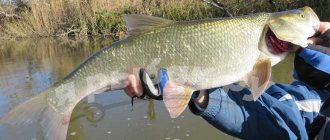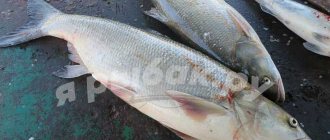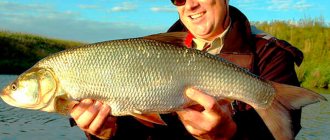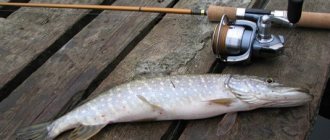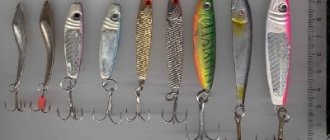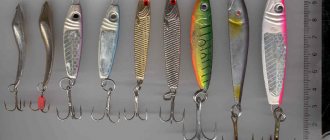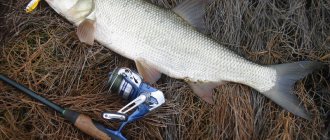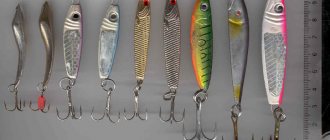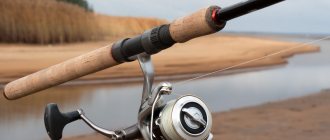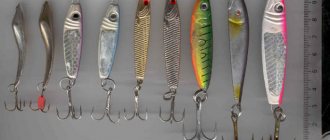Catching an asp is an indicator of the true skill of a fisherman. For successful hunting, beginning spinning anglers will need not only special tackle, but also special fishing skills. The silvery beauty is considered one of the leaders in resistance; the strength indicators of the asp are higher than those of pike perch, pike, and other underwater inhabitants.
Asp fishing
For catching asp on a spinning rod
You can quickly catch an asp immediately after spawning or during the full moon phase. At this time, he actively feeds and takes most of the bait. They are caught both during the day and at night, during the warm season from spring to autumn, with the exception of the spawning period. The water level at the fishing spot plays an important role, especially when the fish is on the hook and its chaotic race has begun.
Did you know? Due to the special way of hunting, the asp is also called “horse” or “grab”. Jumping out of the water, it falls on top of the victim, making a loud bang as it hits the water, which puts smaller fish into a stupor.
It should either be constant or gradually increase. The predator prefers not to swim in shallow water and bites there very rarely. Guard him in the shallows, near aquatic plants, in places where the current accelerates. Asp is a schooling fish, and if you catch one, there are always a couple of others nearby. The aggression and tenacity of the caught fish force anglers to use durable equipment that can withstand the speed and pressure.
Of course, for this you will need a spinning rod with standard equipment:
- rod;
- reel with fishing line;
- hooks;
- spoon.
Characteristics of the main elements:
| Name of gear | Peculiarities |
| Rod | parabolic system; length - 3 m; test range - 20–40 g; material of manufacture - metal, carbon; large diameter guide rings; strong reel seat. The predator attacks a moving bait, attacks and continues moving. Therefore, you need to worry about the strength of the gear and fastening. |
| Coil | high-speed, inertia-free; size - 3000–4000. |
| fishing line | monofilament; cross-section diameter - 0.15–0.18 mm; footage - from 100 m to 120 m. The color of the fishing line may vary depending on the weather and water conditions. Golden is suitable for bright sunny days when it reflects the sun's rays. It will also be good for muddy ponds. Silver or blue-silver is suitable for a cloudy day. In a clean reservoir it is worth using a transparent fishing line, in a polluted and muddy one - brown. |
| Leashes | Not needed, because the predator does not have teeth or sharp fins that can cut the fishing line. |
| Hooks | At least 2 pieces, No. 7-8. The bait is placed on 2 hooks at once, otherwise the predator removes the bait and leaves. |
| Spoon | Kastmaster is the best long spinnerbait with a weighted top. Essentially, it is a cylinder with the top and bottom cut off at angles of 17° and 23°, respectively. The coating is galvanic. At the top there is a loop for attaching fishing line, and at the bottom there is a treble hook. The manufacturer of the original model is Acme. There are many replicas of this excellent catching spoon on the market, but how effective they are must be checked directly by fishing. |
Important! On a sunny day, a spinner is needed with a yellowish (golden) and copper tint, and on a cloudy day
—
with silver.
What to fish with
Spinning
Spinning is the ideal tackle for catching this fish in the summer. It attacks the bait not from an ambush, but, as it were, by stealth. That is, it catches up with the bait that it noticed. That's why they make long casts.
Gear selection
Take two-handed spinning rods up to 3 m long and a high-speed reel. Use a monofilament line no larger than 0.25 mm in diameter. The color of the fishing line is selected to suit the location. The main thing is that it is not unnoticeable in the water.
If a large trophy is expected, then it is better not to increase the thickness of the fishing line, but to make it stronger. Otherwise, a thick fishing line will affect the play of the spoon and will be noticeable to the fish.
The best baits for fishing
The bait is taken based on the river robber’s favorite delicacies: not large, narrow and silvery. For example, long-range spinner spoons with a narrow blade and weight.
Another option is a spinner spoon - Kastmaster from Acme Tackle. There are not many options with shakers that the asp would like. Some spinners are included in separate subparagraphs in the article due to the peculiarities of their wiring.
If it is not possible to use the variations of spinners listed below, then it is better to focus on spinners similar to those of the Kastmaster. There are also primitive options, but they are very catchy. This is a spinner in the form of an oblique cut of a cylinder and a triangular spinner.
Choosing bait depending on fishing conditions and time
On clear days, spinners are taken with a yellowish (golden) and copper tint. In cloudy weather, when it gets dark and in the morning, white and silver colors are suitable.
How to catch asp using a spinning rod
First, they fish upstream in those areas where the asp presumably lives. They start with close casts, gradually increasing them.
The cast is made immediately instead of “fighting” the asp. Place the bait in the direction the fish is moving, and not in the place where the “fight” was noticeable.
The bait is placed near the upper layers of water in spring and summer, and along the bottom in autumn. The asp grabs the cutting bait and greedily. When fishing for this predator, the main thing is to tire it out. But do not overdo it, otherwise the line will not withstand the pressure of the asp.
First, they fish upstream in those areas where the asp is supposed to live.
Float tackle
Gear selection
The float is installed transparent, in the shape of a ball. By the way, there are floats on sale specifically for float fishing for asp. This can be water-filled or with a special load. But it is best to buy water-based ones.
The line is from 0.2 to 0.3 mm in diameter. Hooks size 7-10.
The rod must be strong and not shorter than 3.6 m. The reel must be installed without inertia for long-distance casting of bait. The reel clutch is adjusted to the sharp impacts of the asp.
Lures for fishing
The following are used as hook bait: chafers, bleak, perch, tadpoles, small frogs. The distance from the bait to the float must be at least one meter.
After casting, the rig is released with the flow, gradually releasing the line. It is best to cast from a bridge or boat. If you use small fish, then make long casts. They hook the baitfish by the lips.
Lures depending on fishing conditions and time
The requirements for baits are the same as when equipping a spinning rod, but you can also use dark ones with bright splashes of other colors, as well as baits with iridescent colors.
Bombard
This equipment is ideal for spring and autumn fishing. The bombard has fewer hooks compared to other equipment. The tackle is not equipped with a sinker and a float.
The asp bites on the bombard in a variety of ways: with a strong blow when fishing against the current, with gentle pokes when fishing behind the current or with a sharp jerk. If the retrieve is slow, then the fish bites smoothly and accurately.
Gear selection
They use a spinning rod with dough in the range from 15 g to 55 g, three meters long, a spinning reel with a reserve of 3000 or 4000, a braided cord 0.16 mm in diameter, compact spinners of 20-30 g (preferably castmasters) with turbines, monofilament leads of 0.25-0.3 mm. The longer the leash, the better the bait plays. That is why leashes are taken up to one meter long.
The bombards themselves weigh 25-35 g with a durable antenna. For outdoor fishing, it is enough to take 3 pieces. Two white and one dark. This one in case of poor visibility.
The bombard is strung on a cord, after which an 8 mm plastic bead is put on. A triple swivel of increased size is secured with a blind loop. The bead will protect the fisherman from getting the bombard antenna stuck in the swivel.
There is a small note about the length of the spinning rod. Can also be used in 3.3 m lengths, but experience is required. Yes, and beginners can use reels of size 2500 from any manufacturer. The clutch is set to release easily. The turbines take 1.3 g zeros, similar to Aglia Mepps with yellow petals.
With this style of fishing, the main thing is range. The cast can be made vertically and smoothly, or sideways with a slight slope.
The second option will be dynamic: first, the tackle is placed behind the back, and the rod is set at a low angle. When the bait swings back, the rod is tilted even lower. And when the bait stops at the maximum distance from the fisherman, they make a swing.
If you are casting into a narrow place, then with your left hand you take the bait by the tee and make a pendulum cast. 3-5 meters before the bait touches the water, slow down the line. Often caught between the catches are asp and chub and perch. I cast with a fan.
Lures for fishing
The tackle is equipped with turbine spinners adapted for bombards. The bait is taken tens of times easier by the bombard itself.
The asp bites on a bombard in a variety of ways: with a strong blow when fishing against the current, with gentle pokes when fishing behind the current or with a sharp jerk.
Fly fishing
They begin fly fishing from the moment insects appear. The gear is used in small rivers overgrown with grass. Any bait that stays near the surface will also work.
Therefore, fly fishing can be done in places with fast currents and dense underwater vegetation. Throw the bait across the current or 45 degrees downstream.
If they make the first casting option, then the fisherman stands opposite the asp’s stand and also lowers the bait to the side of the predator’s stand. In this case, it is more convenient to catch fish.
In another case of casting, the fisherman stands above the parking lot. It will be difficult to fish, and if there are underwater shelters or thick algae, then it is better to refuse such casts. Asp actively bite after rain or during high water when fly fishing. At the riffles, the water seems to boil during such periods.
Gear selection
The rods take 5-7 (9) fast and medium-fast action, torpedo-shaped line with a short head.
Lures for fishing
For fishing, natural baits are used (very catchy large grasshopper and chafer), light or white streamer like bleak and dace (RM's Floating Streamer, Little Fry, White Fry). You can also take primitive furrows, dry flies of light colors (Elk Hair Caddis). They fish with flies on top, and with insects at the surface and in mid-water.
Bait is carried out in the usual way.
Installation of float gear
The assembly of float gear or donkeys begins with securing the fishing line to the spool of the reel. A loop is made at its end. Then the main line is passed through the loop, twisted into a figure eight and folded. It turns out to be a double ring, and at the end of one of the rings there is a loop.
The resulting structure is put on the reel spool so that the line bends as it rotates, then the reel will rotate normally. This is necessary so that the line on the spool does not turn idle when the fisherman is pulling in the catch. The line is then wound onto a spool and a spinner is tied to the end.
For this:
- Take the tip 15–30 cm long and pass it through the loop for attaching the fishing line.
- Holding the lure in your left hand, wrap the end 4-6 times around a straight section of line that stretches to the reel.
- Pass it through the loop at the eye of the spinner, and then through the loop for attaching the fishing line.
- Tighten the knot.
The friction brake on the reel is adjusted at the rate of 4-5 kg. In this case, if the jerk force is 7-8 kg, the line will hold the asp and allow it to be successfully fished out. As for bait, you need to take several types of it for fishing. In May, fish bite well on chafer larvae and adult beetles .
Find out how to properly catch asp using a spinning rod.
Other large insects are also used - mole crickets, dragonflies, and grasshoppers. Such bait can be submerged, but if you catch it with flies, they must float on the surface of the water, which is not suitable for asp.
Fishing technique:
- Choose a quiet place with a slow current.
- Feed it so that the fry - the asp's prey - will swim to feed.
- Wait until you notice the fight. The predator hits the water with its tail to stun the fry, and then grabs the prey. These splashes are clearly visible.
- Make a cast and start the leader.
Video: how to make tackle for asp
Tackle and equipment
The asp is a cautious fish and finding its habitat in different seasons is not so easy, so the angler needs to be careful when choosing a fishing spot. It is also important to understand what gear and equipment will be effective in the current fishing session and will help you catch the coveted trophy.
Spinning
When catching asp, they use fast-action spinning rods with a dough that is comfortable for casting the baits used. The optimal test is up to 50 grams, this is enough to cast a heavy wobbler or spinner. During a session, the angler has to constantly recast, so the spinning rod should be light with reliable SiC rings.
The length of the spinning rod for fishing from the shore is 2.7-3.30 meters; from a boat it is more convenient to fish with a blank of 2.1-2.4 m. A fast-action carbon spinning rod with a length of 3.0 and a dough of 50 grams is the optimal choice.
Coil
The asp spinning rod is equipped with a spinning reel with a 2500-3000 spool, with a fast drag. When biting a sheresper, the fisherman has to quickly release the line so as not to miss the trophy, and the fast friction brake allows you to feel more confident and timely practice the jerks of the fish.
fishing line
The asp is a strong fish and the reel should have a monofilament line with a diameter of 0.22-0.25mm. When making long casts, it is better to use a thin, rigid monofilament line, which comes out of the spool better and is less noticeable to the fish. Sheresper is very careful and a line thicker than 0.25 can scare away large fish, and you won’t get a bite. Monofilament fishing line stretches even when fishing from a long distance, “forgiving” possible mistakes of the fisherman.
Braided fishing line, with a diameter of 0.16-0.18, is also used when fishing for sheresper, but despite its small diameter, it is opaque and more visible in the water than monofilament. Experienced fishermen take with them at least two spools with them, on which both monofilament and braid are wound. Thanks to this, they have the opportunity to choose the best option for the existing conditions, both in terms of strength and physical properties.
Leashes
Tackle for asp requires the presence of a leash on which the bait is attached. The asp does not have such sharp teeth as pike, so fluorocarbon leashes are used, which is absolutely invisible in the water and will not scare away even a large trophy. A swivel with a clasp is attached to the end of the leash, allowing you to quickly change the leash if necessary.
Fly fishing
Fly fishing is fishing that uses artificial bait to imitate the main prey.
Also read about how to catch asp in the Kuban.
There are quite a few differences from regular fishing with this method of fishing:
- the rod is taken to be light and longer;
- bait - ultra-light, artificial;
- the fishing line is heavier, it provides weight for throwing;
- fishing occurs in moving water;
- you have to be constantly moving and not just sitting in the boat.
Some anglers call this type of fishing a kind of poetry, because getting fish to attack an artificial object is more difficult than using bait with flavors. Artificial baits for asp imitate flying insects.
There are many types and sizes of flies, and what fish are likely to bite depends on what insects they are biting at that time of year. Thus, success largely depends on the knowledge of the fisherman.
Jig
A jig is a rounded artificial bait and one of the most active fishing methods. You need to constantly move the jig in the upper water column. The angler moves the rod up and down, periodically pulling the bait towards him. It is important that the angler constantly pushes the bait by raising and lowering the rod tip. These movements create the appearance of an injured fish that a predator will be happy to bite. Jigging rods come in all sizes, shapes and colors, allowing you to fish with both live bait and artificial bait.
Important! For this type of fishing, use a lightweight, high-quality carbon fiber rod with an ultra-fast action and a featherweight reel. More than other types of fishing, jigging depends on how well you feel the rod.
A good method of fishing is to lower the jig all the way to the bottom and retrieve it very quickly, jerking the tip randomly until the bait rises to the surface, and then repeat. No matter what type of jig you use, you need to know how to set it up. This means choosing one that matches the weight of the depth at which you are fishing. Deep layers of the reservoir require heavier baits for fishing.
Features of jigging fishing:
- position your back to the wind;
- the wind drives the fry (asp prey) to shallow water, take this into account when casting;
- fish in clear water in shallows;
- Vertical swinging of the bait works well only in deep water; in shallow waters, pull the bait along the water column.
Video: jig secrets for beginners
Asp baits
Fishing is done with a variety of baits that imitate fish or insects; they are also caught with Soviet spinners. On the Volga, fans of spinning fishing can use the usual options; the main thing in asp bait is the correct presentation.
Wobblers
Adherents of wobblers consider crank baits that can actively play to be the best baits. The optimal weight when choosing is 6-10 g. Models in demand are:
- Lucky Craft Clutch – suitable for catching fish weighing up to 2 kg, has a good flight range and its own game;
- Renegade Aspius Death – excellent flight qualities.
Lucky Craft cranks
Large bass-type cranks (13 g) and minnow-class wobblers have proven themselves well. You should pay attention to models that play on a uniform retrieve. Orbit 110 wobblers are also suitable.
Turntables
Interest in hunting sheresper often begins with fishing with a spinner. Among the models, it is better to choose those that allow you to make the longest casts.
Turbine turntables
Pinwheels weighing up to 8 grams should not be considered, since only heavy bait will fly further. Preference should be given to rounded petals, which the asp readily accepts. Wiring with these spinners is carried out in various ways:
- downstream. It is important to constantly maintain fast play;
- upstream. Slow wiring, alternating with short pauses, is suitable. The bait will begin to sink down, but the rotation will not stop due to the pressure of the river flow. It is recommended to change the duration of the pause periodically;
- "for demolition." The bait is thrown across the current. The game is supported by slow rewinding in a monotonous rhythm.
Each time the fisherman manages to better understand the predator and find realistic approaches to the desired fish.
Jigs
The main advantage of the bait is its range. In a wide range of models, the best ones are:
- Renegade Iron Minnow – works well in jerks, even retrieves, and on steps;
- Kastmaster is an effective model with a specific shape that can lift bait to the surface. To achieve the desired result, you need to choose the right mass;
- Sabunaev's three-sided model - its characteristic appearance makes it easy to remember the model. Suitable for deep, stepped wiring. The disadvantage of the jig is that it casts over a short distance.
Triangular spinner Sabunaeva
The spinner often comes with a hook decorated with a bright edge that attracts fish.
Devonian
The peculiarities of this type of bait lie in the methods of attaching the blades and their number. Structural moments affect the center of gravity of the spinner. The bait is produced in two versions:
- the blades are attached to the body - twisting of the fishing line is observed, although the problem can be avoided with braided line;
- The blades are separate elements - there is a bearing that facilitates rotation. In sandy reservoirs, the hole often becomes clogged and stops working.
Spinner RB Devon Dragonfly
Retrieving with a demon is often done quickly, cast upward in the direction of the current or at an angle.
Wobbler
A wobbler is an artificial bait that is suitable for fishing in the upper and middle layers of a reservoir.
Its characteristics:
- color - silver;
- length - 7-8 cm;
- form - minou;
- depth of use for asp is 0.5–1.5 m.
Essentially, this is an imitation of live prey, which is hunted by pike, perch, and other predators. In shallow waters, trout and perch also bite on it, and in deeper layers - pike and pike perch.
Find out how to make a spoon for catching asp with your own hands.
With this fishing method you will need:
- spinning rod with a rigid and durable rod;
- fishing line with reel;
- wobbler
The constant movement of the bait allows the fish to catch it in different lighting conditions, including in the evening or early in the morning.
Devonian
Devon spinners are designed for catching predators. By design, it is an oblong teardrop-shaped smooth or faceted shape, at the narrow end of which there is a triple hook, and at the wide part there are blades, like a propeller. Devon was originally invented for salmon fishing and was named after the area where it began to be used - Devonshire, England. It works well with a very fast leader, which makes this bait suitable for asp.
- Among the features of the Devonian the following are noted:
- efficiency when hunting active fish;
- Possibility of use in fast currents;
- long casting range.
To prevent the fishing line from getting tangled when using Devon, domestic models are equipped with bearings.
Did you know? Predators from the Carp family do not have a stomach, so they digest food directly in the esophagus. There it does not have time to be fully absorbed, so asps constantly hunt to keep themselves in excellent physical shape.
Fishing technique:
- Casting is carried out next to water thickets.
- Then the bait is led along a path, keeping to the same level. If there is no result, then after the next cast you need to lead in steps, changing the height within 1 m.
Video: DIY Devon spinner
Castmasters
The catchable spinner bait Kastmaster is one of the best on the market. Its manufacturer is Acme. It works in almost any water and can catch anything from tiny peaceful fish to large predators. The main thing is to choose the right type.
For fishing take the following:
- rod - 2.1–3.3 m;
- test - 35–40 g;
- reel - inertialess, 2000;
- monofilament - 0.2 mm, length 125 m.
Basic fishing strategies:
- A wounded or sick fish that is bitten by an asp should move chaotically. The movement alternates with short pauses when the bait is passive.
- As the potential prey rushes forward, the asp will think it is trying to swim away and may attack.
So, for successful fishing you need several types of bait and different gear. They are chosen depending on the conditions in which fishing takes place. Start with the simpler and more straightforward ones, but try to learn different techniques to increase your chances of success.
Other gear
Jig
This bait is used in late autumn.
The spinning rod is chosen with a length of 2.93 meters and a dough of 7-38 g, a braided line of 0.12 mm in diameter, a weight of 15-18 g.
Lures for fishing
Equipped with small regular vibrating tails (2 inches), twisters and foam fish (5-6 cm). The asp is not picky in color. He doesn’t care whether they are white, green, light green, translucent with glitter.
Silicone baits are equipped with a double hook and attached with a weight through a winding ring.
The bait is passed in stages with a pause of 1.5-3 s.
Wobbler
Spinning with typical equipment as for other asp fishing equipment.
Lures for fishing
It is important when choosing wobblers (for long and accurate casting) to focus on the silver color and length of 7-8 cm; their shape should resemble a “minnow”. As an example, let's name the following models: Aile Magnet YO-ZURI, Rip-n-minnow 65 OWNER CULTIVA, Rigge JACKKAL, dr Minnow DAIWA, Long Cast RAPALA, Count Down RAPALA, MEGABASS X55F, OWNER CULTIVA Zip-n-Ziggy.
The wobblers are allowed to move 50-80 m along the line and the wobbler is pulled over the hunting area of the wandering asp. They also float a wobbler over rolling pits, but then slowly pull it up.
If fishing occurs in bad weather, then use a Rattlin RAPALA wobbler or its sinking analogue with a light vibrotail. They lead it in steps near the bottom.
If you are looking for wobblers that are suitable for certain cases, then give preference to these:
- Zip Baits Rigge measures 56mm. The asp bites in medium and slow currents at 0.5-1.5 m depth.
- Salmo Thrill , suitable for fast, uniform retrieving at depths of 0.5 m.
- Yo Zuri L Minnow 44 showed excellent performance as a wobbler in a fast stream. In this case, you can even delay his play in one place.
- Yo Zuri SS Minnow 70 is used in shallows and riffles. Good maneuverability on the side and, moreover, it will not hit the bottom and thus frighten the cautious river robber.
- Rapala Husky Jerk – in troubled waters. Attracts predators with its sound and beautiful play.
Lures for asp fishing
Devonian
The tackle is standard like for spinners.
Lures for fishing
Take a pair of Devons: left and right rotation. They are changed periodically to avoid severe twisting of the line. It is better to check the attached carabiner several times.
They cast a little further than where the asp splashes. They spend the Devonian water surface. They try to do this so that the Devon reflects the sun's rays into the depths of the reservoir. At the moment when the asp is close to activity and gluttony, Devon is the most promising bait. The size of the Devonian does not play much of a role. It can be large or miniature.
Turntables for asp
Castmasters
Although they are classified as spinners, they require special attention. They stand out for their difference in wiring compared to other spinners.
Gear selection
Rods are taken with a length of 2.1-3.3 m. Often 2.7 meters. The test for them is suitable for 35-40 g. The reel is selected 2000 inertialess, and the monofilament is chosen 0.2-0.22 mm long, 125 m and without “memory”.
If the spinning rod is longer than 2.7 m, then the reel is equipped with 3000 coils and monofilament of 0.24-0.25 mm, all of the same length. Simply Kastmaster casts are easy to make at 100m.
If you are fishing from a boat, then take a cutter with you.
Lures for fishing
The castmaster is either attached directly to the main line with a tightening knot, or an unequipped tungsten leash 20-30 cm long is installed. In this case, the leash and the main line are tied with a loop-to-loop knot, then a swivel and castmaster are attached to the leash. Kastmaster take standard sizes and weights as other spinners.
The castmaster makes any casts. Ultra-long casting will be the most effective. To do this, tilt the rod 25-40 degrees to the horizon. This is due to the strength and direction of the wind.
Postings can also be made of any type.
For example, “drop” fishing is similar to jig fishing, but with some differences. After casting, let the spoon fall into the water column. Subsequently, the fishing line is reeled in very quickly to bring the spinner to the required level.
There are three possible options here:
- Wiring 1-2 meters from the bottom. This is two revolutions of the reel in the case of an average diameter or one revolution with a large spool.
- At half water , which corresponds to four to six revolutions.
- At the surface of the water. In this case, up to twenty revolutions of the coil are required.
Then the castmaster is again allowed to fall to depth and the wiring is done again. And so they repeat until the wiring is completed. The next cast is made to the same place, but a little closer to the fisherman. The castmaster performs best when fishing at depths of about 2 m.
Uniform wiring is suitable for fishing with bait at a depth of at least one meter and no more than 5.
Experienced fishermen advise doing combined fishing. This is when different techniques are varied in one wiring. Then you can choose the style of wiring that is most tempting for the asp.
